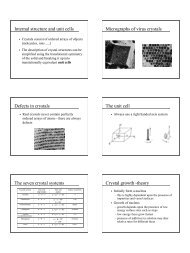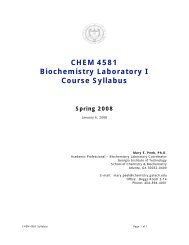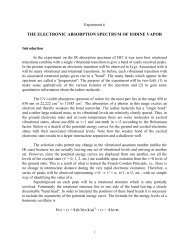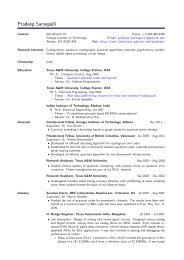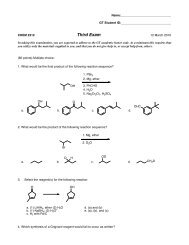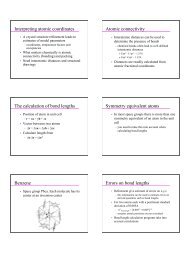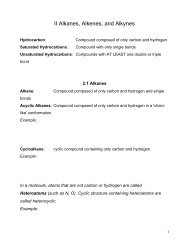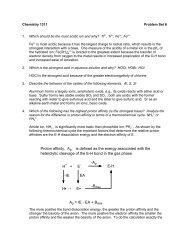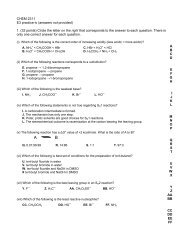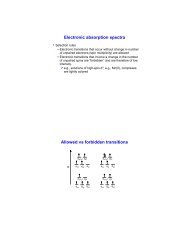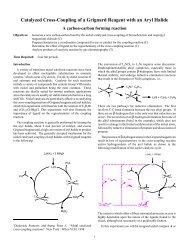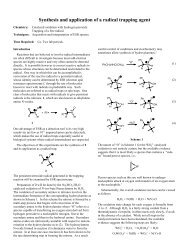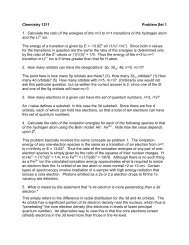Expt. 7 - Conductivity of Electrolytes
Expt. 7 - Conductivity of Electrolytes
Expt. 7 - Conductivity of Electrolytes
Create successful ePaper yourself
Turn your PDF publications into a flip-book with our unique Google optimized e-Paper software.
Experiment 7CONDUCTIVITY OF ELECTROLYTESConductance, G, is the reciprocal <strong>of</strong> resistance, R. Resistance is expressed in ohms,Ω. The SI unit <strong>of</strong> conductance is the siemans, S, and 1 S = 1 Ω -1 . Although resistance is thequantity measured, conductance is more appropriate for the description <strong>of</strong> electrolytesolutions. This is because the conductance <strong>of</strong> a solution is the sum <strong>of</strong> the conductances <strong>of</strong> thesolvent and the solutes. The conductivity κ <strong>of</strong> an electrolyte is related to its conductancethrough the cell constant k cellκ = k cell x GThe conductivity has SI units S m -1 , and may be interpreted as the conductance <strong>of</strong> a cube <strong>of</strong>solution, 1 m on each edge. In this experiment, k cell is determined by implicitly in theconductivity meter by measuring the conductance <strong>of</strong> standard solutions.In the first approximation, the ions move independently during conduction, and theconductivity is expected to be proportional to concentration. An approximately concentrationindependent quantity, the molar conductivity Λ, can be defined in SI units by dividing theconductivity by the concentration in mol m -3 . In terms <strong>of</strong> the molarity c, the molar conductivityis given, in units <strong>of</strong> S m 2 mol -1 , byΛ = κ / 1000cIn fact, Λ decreases slowly with concentration, being approximately linear in thesquare root <strong>of</strong> concentration. At infinite dilution, the ions do conduct independently, and thelimiting molar conductivity, Λ o , obeys a rule <strong>of</strong> additivity,Λ o (AX) = Λ o (AY) + Λ o (BX) - Λ o (BY)where AX, AY, BX, and BY are strong uni-uni electrolytes. The above rule can be extendedto electrolytes like CaCl 2 in a manner that includes the stoichiometric coefficients.An alternative treatment <strong>of</strong> conductivity, found <strong>of</strong>ten in the literature, uses theequivalent conductivity, Λ e . For an electrolyte <strong>of</strong> the form (A Z+ ) ν+ (X Z- ) ν- , the molarconductivity, Λ is related to Λ e byΛ = (ν + Z + )Λ e = (ν - Z - )Λ eFor a weak electrolyte AB with molarity c, the concentrations <strong>of</strong> A + and B - are eachαc, where α is the degree <strong>of</strong> dissociation. The experimental value <strong>of</strong> κ allows the calculation<strong>of</strong> α. The apparent molar conductivity <strong>of</strong> AB, A app , is given by1
Λ app = κ / 1000cOnly part <strong>of</strong> the weak electrolyte is actually present as ions. The molar conductivity <strong>of</strong> theionized part is given by Λ = κ / (l000αc). Assuming that Λ may be approximated by Λ o , itfollows thatα = A app /Λ oThe additivity rule is applied to get Λ o from the proper combination <strong>of</strong> strong electrolytes,because it is not practical to extrapolate Λ to infinite dilution.Experimental ProcedureConductance is measured by immersing the cell in a beaker containing the solution <strong>of</strong>interest. Great care must be taken to wash the cell with the solution first. The followingsolutions are to be measured.1. The standard solutions.2. The distilled water used to prepare the solutions. Add 25 kΩ or 125 kΩ to the resistancebox. The resistance <strong>of</strong> the water will be quite large and not very reproducible. Repeatedrinsing will be necessary.3. The strong electrolytes, NaCl, CaCl 2 , Na 2 SO 4 , NaC 2 H 3 O 2 , and HCl, at 0.01 M, 0.004 M,and 0.001 M.4. The weak acid, HC 2 H 3 O 2 , at 0.05 M, 0.01 M, 0.005 M, 0.001 M, and 0.0005 M.5. A saturated solution <strong>of</strong> CaSO 4 (from the shelf) diluted 1:10. Do not shake this solution.Treatment <strong>of</strong> DataConvert all measured resistances to conductances and subtract the contribution fromwater to get the net conductance <strong>of</strong> the electrolytes. From the net conductance <strong>of</strong> the KClcalculate the cell constant, and from this, the molar conductivities <strong>of</strong> the remaining solutions,except the CaSO 4 .1. For the strong electrolytes, plot Λ versus √c and determine Λ o by extrapolation.2. For acetic acid, determine Λ o from the results for NaCl, Na 2 C 2 H 3 O 2 , and HC1. Calculateα and K a' the acid dissociation constant, for each concentration.2
3. For calcium sulfate, determine Λ o from the results for NaCl, CaCl 2 , and Na 2 SO 4 , andcalculate the concentration in moles per liter <strong>of</strong> the original saturated solution <strong>of</strong> calciumsulfate, assuming Λ = Λ o .Illustrative ProblemAt 25°C, K = 3.40 x 10 -3 S m -1 for 0.00100 M NH 4 OH. Values <strong>of</strong> Λ o are: NH 4 C1 =0.01497, NaOH = 0.02481, NaCl = 0.01265 S m 2 mol -1 . Find the dissociation constant <strong>of</strong>ammonium hydroxide.Answer: 1.80 x 10 -5 .3




